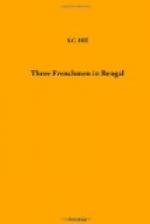[Footnote 112: Ali Gauhar, born 1728. On the death of his father, November 29, 1759, he assumed the name or title of Shah Alam.]
[Footnote 113: The old English Factory at Patna was re-opened by Mr. Pearkes, in July, 1757. See his letters to Council, dated 12th and 14th July, 1757.]
[Footnote 114: Kasim Ali had a much better army than any of his predecessors. Though it was not trained in the European manner, several of the chief officers were Armenians, who effected great reforms in discipline. Three years later it made a really good fight against the English.]
[Footnote 115: The battle is generally known as that of Gaya, but was fought at Suan. The site is marked in Rennell’s map of South Bihar. It lies about six miles west of the town of Bihar, on the river Banowra.]
[Footnote 116: The Banowra River.]
[Footnote 117: The French capital on the Madras coast. Surrendered to Eyre Coote.]
[Footnote 118: Sepoys, so called from the Telingana district in Madras, where they were first recruited.]
[Footnote 119: Mrs. Law. Bibi is the equivalent of mistress or lady. Lass was the native version of Law. Mrs. Law’s maiden name was Jeanne Carvalho.]
[Footnote 120: Bengal Select Com. Consultations, 28th January, 1761.]
[Footnote 121: “A part of these Memoirs was written at Paris in 1703, and part at sea in 1764, during my second voyage to India, but several of the notes were added later.” Law.]
CHAPTER IV
M. COURTIN, CHIEF OF DACCA
Jacques Ignace, son of Francois Courtin, Chevalier, Seigneur de Nanteuil, and of Catherine Colin, is, I believe, the correct designation of the gentleman who appears in all the records of the French and English East India Companies as M. Courtin, Chief of the French Factory at Dacca.
In June 1756, when Siraj-ud-daula marched on Calcutta, he sent word to his representative, the Nawab Jusserat Khan at Dacca, to seize the English Factory, and make prisoners of the Company’s servants and soldiers. The English Factory on the site of the present Government College, was—
“little better than a common house, surrounded with a thin brick wall, one half of it not above nine foot high.” The garrison consisted “of a lieutenant” (Lieutenant John Cudmore), “4 serjeants, 3 corporals, and 19 European soldiers, besides 34 black Christians[122] and 60 Buxerries."[123]
[Illustration: DACCA, OR JEHANGIR NAGAR. (After Rennell.)]




